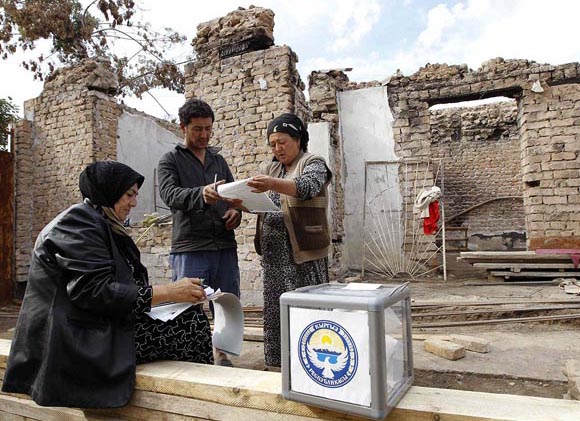A panel discussion on modern Eurasian authoritarian regimes took place at Columbia University’s Harriman Institute last week. A group of human rights experts shared their insights on the dangerous ways that these regimes have developed in most of the former Soviet republics.

Elections in Kyrgyzstan, as well as in many other countries in Central Asia, are said to be manipulated by the government
The panel, entitled “The Strategic Backlash Against Human Rights Across Eurasia,” brought together four prominent participants: Graeme Robertson (University of North Carolina—Chapel Hill), Christopher Walker (Freedom House), Hugh Williamson (Human Rights Watch), and Robert Templer (International Crisis Group). Alex Cooley of Barnard College moderated the event.
As recent research shows, most former Soviet republics over the last 20 years have developed political systems that can be described as authoritarian or semi-authoritarian (hybrid) regimes. Countries that fit the first type of regime include Turkmenistan, Tajikistan, Kyrgyzstan, Uzbekistan, and Belarus, while the second type includes Russia, Armenia, and Azerbaijan. Moldova, Ukraine and Georgia are conventionally recognized as countries in the midst of a democratic transition. But the latest political shifts in many of these countries calls for the revision of these classifications.
All the experts pointed out that modern authoritarian regimes go through various permutations, which makes it hard to describe and categorize them.
“They [governments of the authoritarian and semi-authoritarian countries] adopt various techniques to appear that they are moving towards a democracy, but in actuality, the exact opposite is happening. These techniques are effective but also very confusing,” said Robertson, who recently published a book on the protest activities in such countries.
Walker reinforced Robertson’s argument and described some of these techniques: distorting and contesting the term “democracy” itself (i.e. “sovereign democracy” in Russia), media manipulation (the use of censorship and the consolidation of state-owned media, etc.) and illiberal education (selective erasure of history, exposing the younger generations to anti-Western views, etc.).
Walker also mentioned the dangers of cooperation among authoritarian regimes: “[They] have parallel organizations and learn from each other.”
Another danger is the seductive and glamorous image that these regimes convey. An example is Russia, where the regime has created a raw and sexualized image of the national leader. Photographs of prime minister Vladimir Putin half naked, riding a horse, or playing with a leopard, appear all over the media.
Templer compared the situation in Central Asia to the case of Western Africa, where only several decades ago, countries first won their independence but then quickly plunged into authoritarianism. Later, some countries (i.e. Sierra Leone and Rwanda) faced violent conflicts that remain unresolved to this day. In Templer’s opinion, many Central Asian republics followed that same dangerous path.
With the reality of these situations, all the experts agreed that international organizations like Freedom House, Human Rights Watch, International Crisis Group, and others, need to contribute to the changing political discourse in the former Soviet republics. The problem is that these organizations have already failed in the region and need to come up with new methods to win over the narratives and governments of these countries.
“The idea of democracy should be associated not with ‘Western values’ but with human dignity,” suggested Williamson. And Robertson added: “It is important for Western governments to stop arguing about the merits of democracy and instead focus more on why democracy is an inherently more stable system than authoritarianism.”
Olga Khvostunova

